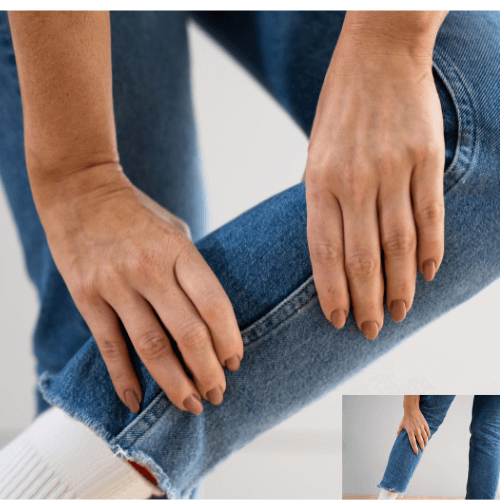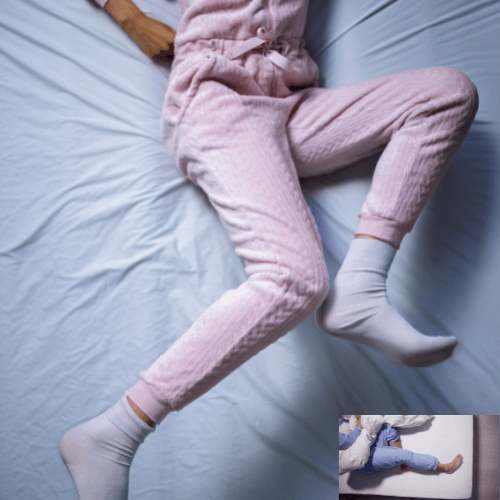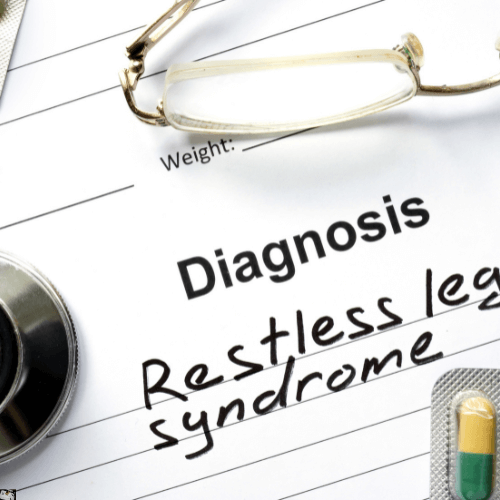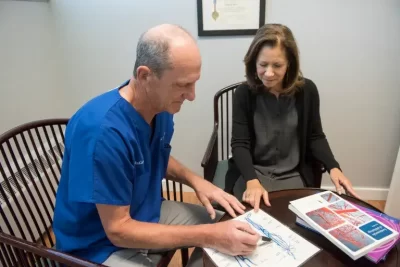Who Is Most Likely to Have Restless Leg Syndrome (RLS)?
- Iron Deficiency: Low levels of iron in the body.
- Kidney Disease: Chronic kidney issues can worsen symptoms.
- Pregnancy: Common among pregnant women due to hormonal changes.
- Diabetes: Poor glucose metabolism may contribute to RLS.
- Parkinson’s Disease: A degenerative brain condition linked to aging.
- Hypothyroidism: Insufficient thyroid hormone production.
- Fibromyalgia: Associated with chronic muscle and joint pain.
- Rheumatoid Arthritis: Immune system attacks joint tissues, increasing discomfort.
- Uremia: A condition linked to impaired kidney function.
- Depression: Can affect sleep and exacerbate RLS symptoms.

Common Symptoms of Restless Leg Syndrome
- Sleep Disturbance: Difficulty falling asleep due to leg discomfort.
- Uncomfortable Limb Sensations: Itching, crawling, throbbing, or burning feelings, especially at night.
- Urge to Move: Persistent need to move legs or arms to relieve discomfort.
- Daytime Sleepiness: Caused by poor-quality sleep at night.
- Bedtime Behavior Problems: Restlessness and inability to stay in bed due to limb discomfort.

Diagnosing Restless Leg Syndrome
- An overwhelming urge to move the legs or arms due to discomfort.
- Symptoms improve with movement, such as walking, stretching, or exercising.
- Discomfort worsens during periods of inactivity, especially in the evening or night.

How to Treat Restless Leg Syndrome
- Regular exercise.
- Following a balanced diet.
- Avoiding caffeine (coffee, tea, chocolate).
- Using heat or cold pads for relief.
- Soaking in a warm bath before bedtime.
- Reducing stress levels.
- Taking magnesium supplements (consult your doctor).
The Willis-Ekbom disease is another name used for restless leg syndrome. It is a disorder that causes a painful feeling in the legs and an undesirable urge to move the arms or body. The restless leg syndrome comes with other sensations in the limbs that are described as creeping, pulling, itching, throbbing, aching, burning, or crawling. It occurs typically when a person is sitting or lying in bed for a long time, like driving or at a theatre. Individuals are most likely to experience restless leg syndrome in the evening and night while getting sleep.
Who Is Most Likely To Have Restless Leg Syndrome?
In some cases, restless leg syndrome is genetic that can run in families. Almost 92% of individuals with restless leg syndrome can transfer this disease to their families. Such individuals are more likely to experience restless leg syndrome symptoms earlier in life than those with no family history of this disease. Furthermore, the genetic source and numerous medical problems are closely linked with the growth of restless leg syndrome; some of them are mentioned below:
- Iron deficiency: It is the low level of iron in an individual’s body.
- Uremia: It is a condition linked to worsening kidney function.
- Depression: It refers to a condition that affects the ability and mood of an individual.
- Hypothyroidism: This illness occurs when the thyroid gland does not release and create enough thyroid hormones in an individual’s blood flow.
- Fibromyalgia: Individuals diagnosed with fibromyalgia are most likely to encounter joint, chronic, and all-over muscle pain.
- Parkinson’s disease: This illness is linked to age; this is also known as a degenerative brain condition. It leads to parts of an individual’s brain deteriorating.
- Kidney disease: Kidney disease means the individual’s kidney isn’t working correctly. The kidney functions get slow and worsen with time.
- Diabetes: It occurs when an individual’s body cannot take glucose into its cells and utilize it for energy.
- Rheumatoid arthritis: A kind of arthritis where an individual’s immune system attacks the tissues, lining, and joints on both sides of an individual’s body.
- Pregnancy. During pregnancy, most women suffer from restless leg syndrome.
What Are The Possible Indications Of Restless Legs Syndrome?
Following are the indications of restless legs syndrome:
- Sleep disturbance: An individual require more time to sleep as the desire for the movement of legs in an individual with RLS makes the discomfort.
- Leg or arm disturbance: The uncomfortable limb feelings are described as itching, crawling, throbbing, tugging, gnawing, or burning. Individuals are most likely to encounter these indications at night.
- Bedtime behavior problems: As the discomfort continues and makes an individual unable to sleep, he might feel the need to get out of bed and stretch the limbs to relieve the pain.
- Urge to move restless legs: To eliminate limb pain, an individual must remove their limb, especially when lying down or sitting down.
- Daytime sleepiness: Issues with falling asleep lead to daytime sleepiness.
What Are The Possible Ways To Diagnose Restless Leg Syndrome?
There are no proper diagnostic tests for restless leg syndrome; however, the diagnosis depends on an individual’s medical condition and symptoms. During consultation for restless legs syndrome, the consultant may ask questions about medical background and suggest having a medical examination such as a neurological, physical, and blood exam. The consultant can also request an individual for an overnight sleep investigation to evaluate sleep apnea and sleep discomfort. To verify the diagnosis of restless legs syndrome, an individual must have the following indications:
- A desire or urge to move the legs or arms occurs typically when an individual experiences uncomfortable feelings like tugging, burning, itching, crawling, aching, or burning.
- Having a desire to move or painful feelings when:
- There are totally or partially relieved by movements like stretching, exercising, walking, or working out the affected muscles.
- It begins or worsens during relaxation or inactivity.
- It happens solely at night.
How To Treat Restless Leg Syndrome?
The treatment of restless leg syndrome depends upon the severity of the symptoms. The healthcare advisor will study the symptoms and recommend possible treatment accordingly. Based on the symptoms of an individual, the healthcare advisor can suggest non-drug treatments like:
- Getting regular exercise.
- Following a healthy appetite.
- Avoid caffeinated products like coffee, tea, and chocolates.
- Applying heat or cold pads.
- Soaking in a warm tub.
- Reduction in stress level.
- Intake of magnesium supplements.
References
- https://www.medicalnewstoday.com/articles/7882 retrieved on 31 Aug. 22
- https://my.clevelandclinic.org/health/diseases/9290-depression retrieved on 31 Aug. 22
- https://my.clevelandclinic.org/health/diseases/12120-hypothyroidism retrieved on 31 Aug. 22
- https://my.clevelandclinic.org/health/diseases/4832-fibromyalgia retrieved on 31 Aug. 22
- https://my.clevelandclinic.org/health/diseases/8525-parkinsons-disease-an-overview retrieved on 31 Aug. 22
- https://my.clevelandclinic.org/health/diseases/15096-kidney-disease-chronic-kidney-disease retrieved on 31 Aug. 22
- https://my.clevelandclinic.org/health/diseases/7104-diabetes-mellitus-an-overview retrieved on 31 Aug. 22
- https://my.clevelandclinic.org/health/diseases/4924-rheumatoid-arthritis retrieved on 31 Aug. 22
- https://my.clevelandclinic.org/health/diseases/9497-restless-legs-syndrome retrieved on 31 Aug. 22
https://www.mayoclinic.org/diseases-conditions/restless-legs-syndrome/symptoms-causes/syc-20377168#:~:text=Restless%20legs%20syndrome%20(RLS)%20is,eases%20the%20unpleasant%20feeling%20temporarily retrieved on 31 Aug. 22







